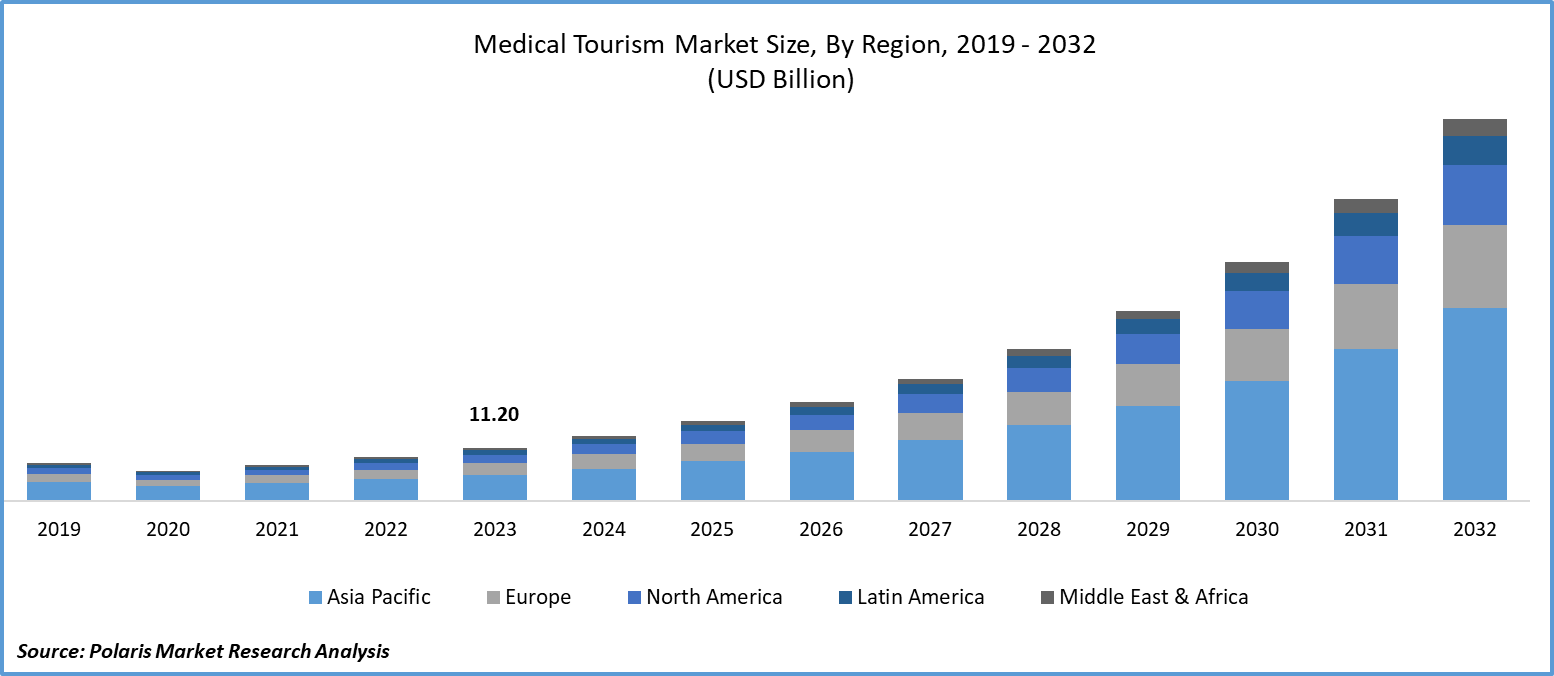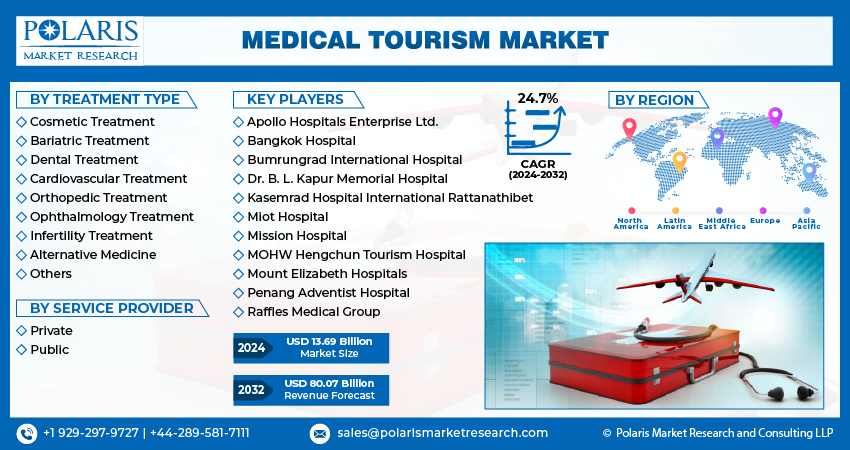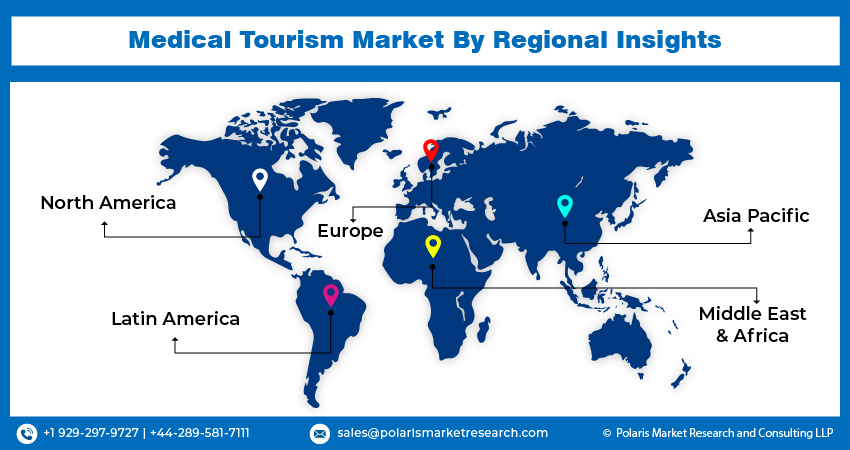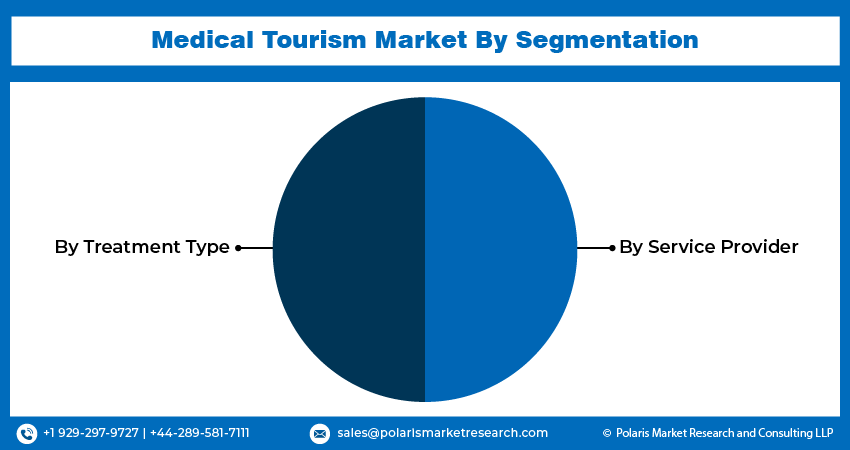
Medical Tourism Market Share, Size, Trends, Industry Analysis Report, By Treatment Type (Cosmetic Treatment, Bariatric Treatment, Dental Treatment, Cardiovascular Treatment); By Service Provider; By Region; Segment Forecast, 2024 - 2032
- Published Date:Apr-2024
- Pages: 118
- Format: PDF
- Report ID: PM1523
- Base Year: 2023
- Historical Data: 2019-2022
Report Outlook
Medical tourism market size was valued at USD 11.20 billion in 2023. The market is anticipated to grow from USD 13.69 billion in 2024 to USD 80.07 billion by 2032, exhibiting a CAGR of 24.7% during the forecast period.
Medical Tourism Market Overview
Medical tourism enables patients to travel abroad for treatment rather than enduring long waiting times for care in their home country. Consequently, many international patients opt for medical tourism, seeking procedures promptly in nations offering expedited services to save time and prevent the worsening of their medical conditions. Furthermore, numerous national governments are employing diverse strategies to promote health and wellness tourism within their borders. Thus, robust government support is anticipated to foster the medical tourism market expansion.
Further, medical tourism market growth is fueled by a rising number of individuals seeking medical care abroad, advancements in healthcare technology, escalating healthcare costs, and an increasing demand for specialized treatments. The primary catalyst for medical tourism market expansion is the exorbitant healthcare expenses in individuals' home countries. Furthermore, the surge in demand for non-insurance procedures such as dental reconstruction, cosmetic surgery, reproductive therapy, and gender reassignment surgeries is contributing to the sector's development.

To Understand More About this Research: Request a Free Sample Report
For instance, in March 2024, Bumrungrad International Hospital, led by CEO David Boucher, is in healthcare with over 1.1 million patients from 190 countries in 2023 and innovative services in Phuket.
Due to travel bans, supply chain disruptions, movement restrictions, and other factors, such as the COVID-19 pandemic, have had a major negative impact on the medical tourism industries, including well-known medical tourism destinations such as China, India, and other growing nations. India's medical tourism industry suffered during the first two years of the pandemic due to travel restrictions.
For example, according to Fortis Healthcare's annual report, travel restrictions had a significant influence on the medical tourism market development in 2021 as the number of patients from adjacent countries stopped traveling.
Medical Tourism Market Dynamics
Market Drivers
Elevated Medical Expenses in Advanced Economies
In underdeveloped nations, individuals can access high-quality medical care at a fraction of the cost compared to developed nations. Despite the affordability of medical treatments in these countries, quality is upheld as resources are available at relatively lower prices. This factor prompts people to relocate to these countries to avail themselves of healthcare services.
For instance, while the average cost of an Angioplasty operation in the United States ranges between $55,000 to $57,000, the same procedure in Malaysia costs between $2,500 to $3,500. Consequently, individuals from the United States and other European nations opt to travel to Thailand, Singapore, India, and Malaysia for medical treatment, saving between 55 to 70 percent of the total cost of care.
Absence of Insurance Coverage in Nations
In the United States, insurance providers typically exclude coverage for many elective surgeries, such as weight loss, cosmetic, and certain dental procedures. This lack of coverage or limited availability prompts individuals to seek medical treatment in countries like Malaysia and Thailand. Since most cosmetic procedures are considered elective in many countries, they are not covered by medical insurance, leading patients to explore treatment options abroad. By seeking treatment in locations where medical procedures are more affordably priced, patients can save money.
For instance, while the cost of a breast augmentation procedure in the United States ranges from $5,000 to $8,000, the same procedure in Malaysia costs between $3,000 to $4,000.
Market Restraints
Concerns Regarding Medical Tourism from Medical and Ethical Perspectives
The medical tourism market is expanding, yet it also presents possible medical risks. Instances of nosocomial infections and hospital-acquired infections are heightened when individuals travel for medical treatment. Risks include the transmission of noroviruses, often causing severe gastroenteritis, infections from multidrug-resistant organisms, and mycobacterial infections following cosmetic procedures.
Additionally, there's a concern for public health in the tourists' home countries as they may bring back infections not commonly encountered locally. In the last twenty years, there has been a noticeable increase in transplant tourism, leading to higher rates of tissue rejection post-surgery. Variations in medical ethics between nations are also apparent.
For instance, a treatment such as stem cell therapy, deemed experimental in one country, may be routinely administered to international patients at private hospitals. However, by taking appropriate precautions when seeking medical treatment overseas, these risks can be mitigated.

Report Segmentation
The market is primarily segmented based on treatment type, service provider, and region.
|
By Treatment Type |
By Service Provider |
By Region |
|
|
|
To Understand the Scope of this Report: Speak to Analyst
Medical Tourism Market Segmental Analysis
By Treatment Type Analysis
- The dental treatment segment is projected to grow at the fastest CAGR during the medical tourism market forecast period. Dental treatments can be costly in numerous countries, particularly for complex procedures, prompting medical tourists to seek dental care abroad for substantial savings, even after factoring in travel expenses. Countries renowned for dental tourism, such as Thailand, Mexico, and Hungary, boast well-established dental facilities providing top-notch care. Patients benefit from treatment by experienced professionals utilizing modern equipment and techniques. Dental procedures often entail multiple visits spread over an extended period. Still, some countries offer accelerated treatment options, enabling patients to complete their dental care in a shorter duration, a feature appealing to medical tourists.
- The cosmetic treatment segment led the industry market with a substantial revenue share in 2023. The market is growing due to increasing patient awareness, a greater demand for anti-aging therapies, and the high cost of cosmetic implants in developed countries. Thailand is a top destination for cosmetic and bariatric surgery, offering procedures such as hair transplantation, liposuction, cool sculpting, laser tattoo removal, and breast augmentation. On the other hand, surgeries such as hip replacements, gastric bypass, and knee replacements are cheaper in India compared to other wealthy nations such as the UK and the US.
By Service Provider Analysis
- The private segment accounted for the largest market share in 2023 and is likely to retain its position throughout the medical tourism market forecast period. The segment is experiencing rapid growth due to advancements in healthcare technologies and the availability of privately owned, internationally recognized, and accredited providers. Additionally, the private sector offers more privacy and faster services compared to the public sector. To gain access to international buyer networks and healthcare insurance, healthcare facilities in underdeveloped nations are seeking international recognition from regulatory bodies. Insurance companies in wealthy countries are adding health tourism coverage to their medical plans to encourage individuals to seek medical care abroad. Moreover, an increasing number of people without insurance or with inadequate coverage are driving travelers in need of medical attention to seek affordable healthcare services and treatments in underdeveloped countries.
-
The public segment is expected to grow at a significant growth rate over the upcoming years. Public healthcare facilities in many countries are known for providing cost-effective medical services, which appeal to individuals seeking affordable healthcare options. Moreover, some governments actively promote medical tourism to bolster their healthcare sector and economy, often offering incentives to public hospitals to accommodate international patients. These efforts contribute to the growth of the public segment in the medical tourism market development. Additionally, public hospitals in certain countries have gained renown for delivering high-quality medical care, particularly in specialized fields like organ transplantation and cancer treatment, attracting patients from around the globe.
Medical Tourism Market Regional Insights
Asia Pacific Dominated the Global Market with the Largest Market Share in 2023
The Asia Pacific region dominated the global market with the largest market share in 2023 and is expected to maintain its dominance over the anticipated period. In the region, medical care is more than 90% cheaper than in private healthcare facilities in the United States. For instance, according to the Malaysia Healthcare Travel Council, the cost of coronary artery bypass graft surgery in the US can be as high as USD 92,000, while in India, it costs less than USD 10,000. Additionally, the most favored tourist destinations are distributed across several countries in the region. Malaysia, Singapore, and Thailand are popular choices for medical tourists due to their abundance of attractions for recovering patients, relatively inexpensive cost of living, welcoming locals, and quality healthcare services.
Various countries in the region highlight medical tourism as a significant revenue source for their economies. For instance, the tourism ministries of Thailand, Malaysia, and India have actively promoted medical tourism. Furthermore, investors and private hospital chains see the Asia Pacific medical tourism sector as a profitable opportunity and invest in infrastructure, personnel, technology, and services.
The North America region is expected to hold a significant revenue share during the medical tourism market forecast period. Countries such as the US and Canada have maintained stringent healthcare standards for a long time. With numerous facilities holding international accreditation, patient trust in medical procedures has significantly increased. These nations emerge as prime offshore medical travel destinations, boasting advanced medical technology and a wide array of medical services. These factors contribute to the growth of regional markets..

The medical tourism market is fragmented and anticipated to face heavy competition due to several players' presence. Major service providers in the market are constantly upgrading their technologies to stay ahead of the competition and to ensure integrity, efficiency, and safety. These players focus on partnership, services upgrades, and collaboration to gain a competitive edge over their peers and capture a significant market share.
Some of the major players operating in the global market include
- Apollo Hospitals Enterprise Ltd.
- Bangkok Hospital
- Bumrungrad International Hospital
- Dr. B. L. Kapur Memorial Hospital
- Kasemrad Hospital International Rattanathibet
- Miot Hospital
- Mission Hospital
- MOHW Hengchun Tourism Hospital
- Mount Elizabeth Hospitals
- Penang Adventist Hospital
- Raffles Medical Group
Recent Developments
- In February 2023, Penang is aiming to enhance its medical tourism sector through a strategic partnership between Penang Adventist Hospital and Firefly Airlines.
- In January 2023, The India Tourism Development Corporation and the Ministry of Ayush agreed to boost medical tourism in Ayurveda and other traditional medical systems. According to a statement, the ITDC will promote "Heal in India Medical Value Travel in Ayurveda, Yoga, and other Indian traditional medical systems."
- February 2024: Egypt’s Ministry of Tourism announced the launch of a unified platform for health and tourism that offers both medical and healing services.
- January 2024: PT JCB, Indonesia, a part of JCB International Co., Ltd. (JCB), and Sunway Healthcare Group collaborated and agreed to introduce the services of Sunway Healthcare Group to more than 156.0 million JCB card membership holders globally in order to promote medical tourism.
Report Coverage
The medical tourism market report emphasizes key regions across the globe to understand the product to the users better. It also provides market insights into recent developments and trends and analyzes the technologies that are gaining traction around the globe. Furthermore, the report covers an in-depth qualitative analysis pertaining to various paradigm shifts associated with the transformation of these solutions.
The report provides a detailed analysis of the market while focusing on various key aspects such as competitive analysis, treatment type, service provider, and their futuristic growth opportunities.
Medical Tourism Market Report Scope
|
Report Attributes |
Details |
|
Market size value in 2024 |
USD 13.69 billion |
|
Revenue Forecast in 2032 |
USD 80.07 billion |
|
CAGR |
24.7% from 2024 – 2032 |
|
Base year |
2023 |
|
Historical data |
2019 – 2022 |
|
Forecast period |
2024 – 2032 |
|
Quantitative units |
Revenue in USD billion and CAGR from 2024 to 2032 |
|
Segments covered |
By Treatment Type, By Service Provider, By Region |
|
Regional scope |
North America, Europe, Asia Pacific, Latin America, Middle East & Africa |
|
Customization |
Report customization as per your requirements with respect to countries, region, and segmentation. |
FAQ's
key companies in Medical Tourism Market are MOHW Hengchun Tourism Hospital, Apollo Hospitals Enterprise Ltd., Bumrungrad International Hospital, Mount Elizabeth Hospitals
Medical tourism market exhibiting the CAGR of 24.7% during the forecast period
The key segments covered by the medical tourism market report are treatment type, service provider, and region.
The elevated medical expenses in advanced economies are driving the medical tourism market growth
The global medical tourism market size is expected to reach USD 80.07 billion by 2032

